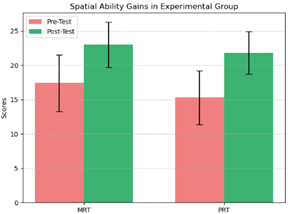Enhancing Spatial Ability and Engineering Graphics Performance through Structured Spatial Skills Training: A Quasi-Experimental Study
Keywords:
Spatial Ability, Mental Rotation, Spatial Visualization, Visuospatial Working Memory, Engineering Education, Spatial Training Intervention, Engineering GraphicsAbstract
Spatial ability plays a foundational role in success across STEM disciplines, particularly in engineering education, where skills such as mental rotation, spatial visualization, and visuospatial working memory are critical. This study investigates the impact of a structured, 12-week spatial training intervention on undergraduate students’ performance in engineering graphics. A quasi-experimental design was implemented with 60 participants, divided equally into experimental and control groups. The intervention integrated progressive 2D-to-3D tasks, computer-aided exercises, and real-world sketching activities. Pre- and post-intervention assessments included the Mental Rotation Test (MRT), Picture Rotation Test (PRT), and domain-specific engineering drawing evaluations. Results revealed statistically significant gains in all spatial subskills and engineering performance metrics in the experimental group compared to the control group. Large effect sizes (Cohen’s d > 1.2) were observed for mental rotation and spatial visualization improvements. The findings align with recent literature on spatial cognition and STEM learning, supporting the incorporation of targeted spatial training in early technical education. This research contributes to the growing evidence base for embedding spatial skills curricula to enhance student performance, engagement, and long-term retention in spatially intensive disciplines.


